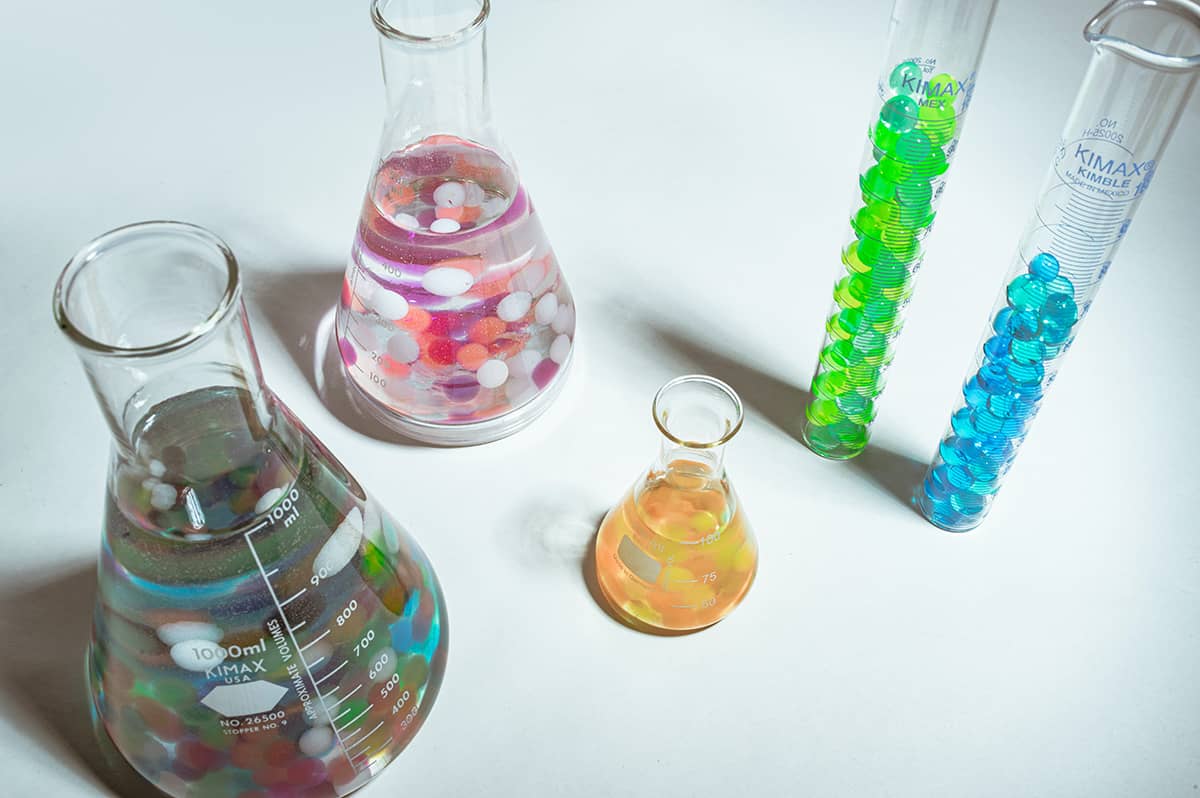Synthetic compounds have become increasingly popular since the industrial revolution.
Synthetics comprise almost all of the pharmaceutical industry, which itself is the largest arm of the medical industry. Natural medicine used to be the only option. Without the use of any synthetic substances, people were able to live healthy lives that may not have been as long as ours but were certainly filled with more vigor and energy.
Synthetic materials and fabrics have also allowed for the rapid production and expansion of society and those living in it. Natural materials restricted people from building relatively close to where the resources could be harvested. The advent of synthetic materials (as well as modern shipping techniques which themselves require vehicles made from synthetic goods) have allowed us to build anywhere in the world.
This begs the question, which is better? Synthetic or natural? There are lots of arguments for either side of the picture. This article will hopefully help you answer this question for yourself.
What’s the Difference?
First, it helps to clear up some misconceptions and provide a clear definition of both synthetic and natural. There is some discrepancy regarding the definition of these terms depending on who you ask and which circle you’re involved with. Here we’ll provide general definitions that should be applicable in all situations.
Natural


Natural things are those which are found in nature.
Things like trees, roots, animals, and clouds are all-natural. However, when it comes down to the production of medicine or the manufacturing of building materials, things are not always so cut and dry.
To clarify something is natural, generally, it must be derived from nature and minimally processed. Plant extracts that have not been synthetically altered are still considered natural as are building materials made from materials that have not been significantly modified.
Semi-Synthetic
Semi-synthetic products are generally a bit harder to define and may consist of an amalgamation of natural and synthetic products, or they may be a natural product that has been modified synthetically.
In this case, the natural base of the product will retain its natural, original state but the synthetic modifications will be apparent enough to ensure that the product is its own, unique substance.
Synthetic


Synthetic products are made entirely in a laboratory. The majority of pharmaceutical compounds are completely synthetic, for example. There are also several food additives that are made in a laboratory and cannot be found in nature. Synthetic products are also used to create consumer goods and often provide a cheaper alternative to natural goods.
There is some debate as to whether or not natural compounds re-created synthetically should be considered natural or synthetic. For example, many of the vitamins used to create vitamin supplements are produced in a laboratory. Although these compounds are found readily in nature, these particular versions are created by man.
Synthetic or Natural What?
Before moving on, it’s probably a good idea to clarify what, exactly, we are discussing here. The terms synthetic and natural are fairly abstract if they’re not used to describe something like a medicine or practice.
Synthetic and Natural Materials
Synthetic and natural materials can be used to create just about anything.
Homes, for example, which used to be made entirely out of natural materials, are increasingly made from synthetic materials. Some of these synthetic materials can provide added convenience, such as in the case of smart houses that are filled with computer technology. However, The number of natural materials and resources required to produce these synthetic materials are often significantly more than one would require to simply build a house naturally.
On the other hand, some synthetic materials are designed specifically to offset the resource consumption involved in various sectors of industry. Some synthetic materials can also be used to create facilities like a recycling center that allows for the repurposing of materials, thereby reducing waste.
Synthetic and Natural Fabrics
A topic of hot debate nowadays is the use of synthetic and natural fabrics. Many people, often vegan and health-conscious or cruelty-conscious folks, have begun to speak out against the use of synthetic fabrics due to the pressure that they place on the environment. Instead, they opt for the use of natural fabrics like bamboo and cotton.


In this situation, synthetic fibers are almost always cheaper. This makes them a much better option for those on a budget. However, those with enough money to spare or enough spare time to think eco-consciously may want to purchase natural fibers.
Fortunately, most natural fabrics can be grown in relatively small regions with minimal resource consumption. For example, hemp can be grown for fabrics easily, quickly with minimal water, and acts as a fantastic carbon sink.
Synthetic and Natural Consumables
The debate between natural and synthetic products takes place much more often among those who are discussing consumable products such as food, vitamins, supplements, and medicine. The greatest, or at least the most significant area of debate is in medicine.
These issues are of paramount importance because they deal with the things that we consume directly. These things will have the most profound effect on our health and therefore it’s most important for us to determine whether natural or synthetic things are better in this regard.
Synthetic and natural nutrition
Many synthetic nutritional products are available on the market. Some of these are supplements that are entirely synthetic. Others are synthetic re-creations of natural products. And yet others are completely natural products derived from nature with minimal modification.
In the case of vitamin supplementation, it can certainly be more cost-effective to produce these nutrients in a laboratory rather than extracting them from live plants or animals. And, in regard to animals, vegans and vegetarians who need to supplement their diet with nutrients like vitamin B12, which can be found only in negligible amounts in plants, would likely prefer to do it with a synthetic supplement rather than an animal-derived product.
On the other hand, there are a large number of scientists who have proven that naturally-sourced vitamins and minerals are better absorbed – at least when they are consumed as part of a whole food product. Whole foods contain a variety of different nutrients, including proteins, fiber, and vitamins that do not overwhelm the body.
As such, researchers have also discovered that multivitamins are a waste of a lot of nutritional material. The body only has so many enzymes that you can use for processing and digesting nutrients. When it’s stormed by a capsule containing high doses of three dozen different nutrients, it gets overwhelmed.
This might not necessarily be dangerous or toxic, but it certainly results in wasted nutrients while at the same time providing the illusion that you’re reaching your daily allowance. And, because you can’t be certain which nutrients you’re absorbing in which you aren’t, this can create health complications.
Supplements & nootropics
As for nutritional and health supplements, it’s up to you to decide whether or not you would like to get synthetic or naturally derived products.
Of course, some supplements are only available in synthetic form. Many nootropics, for example, are entirely synthetic, having been developed specifically for the purpose of enhancing cognitive function. While there are a number of natural compounds that can enhance cognition, modern-day academics, students, and researchers prefer to tweak their brains and bodies to the maximum using synthetics.


Some of these synthetics, like the racetam family of nootropics, have been used for quite a long period of time and have been the subject of scientific study throughout this time. They seem to be fairly safe while producing consistent effects.
It’s important to note the relationship between potency and risk. “What goes up, must come down,” is a phrase commonly tied to drug use, though it certainly applies to nootropic use, as well. For example, look at the nootropic drugs in the -racetam family. Piracetam is e most well-studied substance in the group and is considered safe, even after long-term use. It’s also the weakest -racetam, and many people don’t even feel its effects.
On the other hand, take something like phenylpiracetam. This nootropic is dozens of times stronger than its cousin piracetam. It can produce some side effects that piracetam might not immediately after ingestion. This may include jittering, anxiety, overwhelm, headaches, and brain fog. Long-term studies have not evaluated the efficacy of phenylpiracetam over the years but one can assume that they might be more severe than those associated with piracetam.
As for natural supplements, you will be able to choose between those that are heavily extracted, often using chemical procedures and those that are naturally extracted or in whole plant form.
Supplements in whole food form are usually powdered and sold in capsules. These products allow you to enjoy the plant as nature intended, albeit processed by somebody else in a factory. If this is the route that you want to go, you should first check to see if these plants grow in your local area and think about harvesting and processing them on your own.
As for extractions, some chemical extractions can produce products that are far stronger than those who would ever find in nature or be able to produce using entirely natural methods. Whether or not this changes the definition of the product from natural to synthetic or semi-synthetic is a matter of some debate.
Synthetic and Natural Medicine & Drugs
The majority of the discussion taking place regarding natural vs. synthetic products regards those that are used in the medical industry. Of all the things mentioned so far, medicine and drugs impact our health and livelihood the most.
As such, people are understandably concerned about how synthetic or natural substances might affect them. Synthetic substances are, by definition, unnatural, and this can put people on edge: many synthetics are made by first dissecting a plant’s chemical makeup and then isolating the most potent compounds, discarding the rest, and deeming the extracted compounds the most beneficial. On the other hand, entire laboratories are dedicated to producing chemicals that are not to be found in the natural world.
This isn’t necessarily a bad thing. Medical science has advanced tremendously thanks to the advent of synthetic materials. We now have access to valuable medical tools like x-ray devices, measurement tools that can evaluate the activity of the brain, and numerous technologies that can save people who are seriously ill and at risk of death.
These drugs can be very powerful – as they’re supposed to be. But they’re also a lot more powerful than what we, as a species, are used to.
Synthetics via Plants & Nature
For most of human history, drugs were entirely natural. For the first thousands of years of human evolution, the only drugs that people used were derived directly from plants and were usually imbibed for visionary purposes to help improve the health and spiritual strength of tribes.
And there’s no real record as to when the first plant extracts came about. It’s likely that plant extraction methods developed alongside the science of alchemy, which itself cannot be traced back to any specific year or era. Nonetheless, we can be fairly sure that people have been extracting plant medicine from medicinal plants for many thousands of years.
These extracts marked the early beginnings of synthetic medicine as well as a change in human thought characteristic of the modern age. We began to think that we could improve upon nature, that mankind knew better than thousands of years of evolution, and could improve the efficacy of plants that had evolved to provide complex medicinal benefits to creatures of all types.
After we began extracting powerful plant medicines, we began to identify specific plant compounds that were responsible for specific benefits and isolate these individual compounds from these plants. This was the result of new science that was derived from alchemy, chemistry. As mentioned in an earlier article, chemistry is merely the physical aspect of alchemy.
That’s not to say that you can’t make alchemical plant extracts. You can. These extracts are incredibly potent and powerful, although few in the modern world have had a chance to try them. Alchemical plant extracts aim to capture not just the alkaloids and phytochemicals found within the plant but also its essence or non-physical spirit.
These extracts, called spagyrics, are among the most difficult to make and yet remain some of the strongest and most powerful medicinal supplements available today. Because of the complications involved in producing spagyric extracts – the same alchemical principles applied to produce either the transmutation of metals or the transmutation of the human soul must be used to effectively for the transmutation of a plant into its purest form – very few people remain who possess the knowledge necessary to produce them.
Regardless of whether a skilled alchemist is making a spagyric or a chemist is extracting alkaloids, these medicines are still generally considered natural unless the extraction process causes significant changes in the alkaloid’s molecular structure. The result of this would be a semi-synthetic product.
And, of course, there is an entirely synthetic medicine. These drugs, which encompass the majority of products on the pharmaceutical market, are completely devised in a laboratory by chemists interested in producing substances that provide a specific benefit.
These medicines may be modeled off of natural components, but the end product cannot be found in nature whatsoever. Aspirin, for example, is the result of chemical reactions performed upon a compound found in willow bark, salicylic acid.
In the middle of the 19th century, chemist Charles Frédéric Gerhardt treated a medicine derived from salicylic acid with acetyl chloride to create, for the first time, acetylsalicylic acid, commonly known as aspirin. Another example is the heart medication digitalis, which is produced by synthetically modifying a compound found in foxglove, a plant that is poisonous to consume on its own.
Synthetic Therapeutic & Recreational Drugs
Recreational drugs are various in nature. Many, like marijuana and magic mushrooms, are entirely natural. Some of them, like LSD – derived from the ergot fungus – are semi-synthetic. Others, such as MDMA, are entirely synthetic.
Most recreational drugs have been proven to have at least some therapeutic benefit. Cocaine, a strong plant extract made from the coca leaf, was historically used by Sigmund Freud to encourage his clients to become more talkative. While this is generally discouraged nowadays, even stimulants like methamphetamine are prescribed in cases of serious ADHD.


The real conflict comes in regard to synthetic psychedelics, however. Psychedelics are some of the most profoundly healing substances on the planet, and modern research is beginning to agree with this in many different ways.
In fact, synthetic psychedelics – when administered in the proper setting, with the right intention – are proving to have similar benefits as plant medicine ceremonies administered under the guidance of a shaman. Instead of a jungle setting, they can be performed in a comfortable office setting, and instead of a shaman, a therapist trained to work with psychedelics may guide the ‘ceremony.’
3 Myths About the “Natural Is Always Better” Trend
I am personally a proponent of natural products being generally a better option when it comes to daily living. Natural supplements, whole, unprocessed foods, natural holistic treatments like massage therapy and chiropractic care are a fantastic way to feel strong and vigorous throughout the day – especially when compared to synthetic drugs, processed foods and synthetic recreational pastimes like watching TV and gaming out (although there’s certainly nothing wrong with these things in moderation!)
However, I think it’s unwise to generalize in any context, and the debate between synthetic and natural products is no exception. Both synthetic and natural goods have their uses. If you break your leg, for example, you might want to go to the hospital for synthetic treatment and medication.
Since most people find themselves deeply polarized on the issue, a lot of fairly extreme viewpoints have emerged. Somebody invested in pharmaceuticals might say that natural alternatives are ineffective whereas proponents of natural medicine often say that anything synthetic must be harmful.
Here are a few of the most common myths associated with synthetic and natural products, treatments and medicines.
#1. Synthetic Compounds Are Always More Dangerous Than Natural Ones
This is simply not true. There are plenty of natural compounds that are highly toxic, such as cyanide and arsenic. On top of this, there are many viruses and bacteria to be found in nature that can lead to illness on earth.
In fact, the world’s most toxic compounds are all found in nature. Botulinum, the toxin which causes botulism, is a natural compound that’s about a million times more toxic than any synthetic chemical yet produced by mankind aside from dioxin (which is still about 100,000 times less toxic than botulinum.)
According to research performed at a California university, about 62% of the world’s known carcinogens are found in nature.
#2. Synthetic Versions of Natural Compounds Are More Toxic / Less Effective Than Their Natural Compounds
In many cases, it can be more cost-effective and easier to produce synthetic versions of natural chemicals, such as vitamins, in a laboratory setting. Some believe that these chemicals are less valuable because they are produced in a lab rather than produced in nature.
There may be some degree of truth to this, but not in the way that most naysayers believe. Instead, it’s a result of the same process that creates difficulties in absorbing multivitamins: your body simply isn’t designed to absorb high amounts of concentrated vitamins at a single time.
The best way to offset this issue is to eat your vitamin with a meal. Because the synthetic version of your vitamin will be the exact same molecule as the naturally produced version (otherwise it would be called something different) then you can expect that it will behave similarly in the body. The main exception to this rule is if the nutrients present in a natural food work together to produce some emergent benefits, such as can be seen in cannabis when full-spectrum extracts produce what is known as the ‘entourage effect’: a more complete healing process.
There are a few exceptions, however. One example is vitamin E. Natural vitamin E, found in foods, is chemically known as d-a-tocopherol. The synthetic version is called dl-a-tocopherol. The latter is a mixture of d- and l-a-tocopherol. So far, no studies have proven that l-tocopherol is harmful to humans, however, it’s known to be about 1.4x less effective than its d-counterpart thus making synthetic vitamin E slightly less effective.
Another thing to be cautious about when taking synthetic versions of natural compounds is the fact that you can easily expose yourself to far higher doses than you would ever be subject to in nature. For example, melatonin supplements – a common sleep aid – provide your body with several thousand times more melatonin than it would generally produce on its own – even when using the lowest-potency products on the market. Higher-potency products can provide your body with more than ten thousand times the amount of melatonin that is usually present!
This can, of course, produce problems in the body. When the body is provided with several thousand times more of a hormone or enzyme than it produces on its own. The body will become reliant on the hormonal supplement to provide the necessary hormones and thus stop producing it on its own.
#3. Organic Food Is Healthier and Therefore Better For You


If you’ve ever actually studied the guidelines that agricultural authorities have set for the growth and distribution of foods, especially in the United States, then you may already know some of the unnerving facts about the definitions of organic and non-organic foods. For something to be considered ‘organic,’ it doesn’t necessarily have to be free from any and all dangerous or toxic pesticides.
In fact, many of the natural pesticides that are used in place of synthetic ones are significantly harmful to human health as well! Tests that have been done on both organic and non-organic foods have shown residue of toxic pesticides on both varieties.
Interestingly, many of the synthetic pesticides have been designed specifically so that they’re less toxic, rather than simply so that they can be more effective. Of course, more long-term safety data is needed in regards to some of these newer products, but this is a promising endeavor.
Final Thoughts – Which Is Better?
So, then, how can you decide which is better? Natural compounds or synthetic ones? Ultimately, the answer depends on what you’re trying to achieve, and what your body needs at the present moment.
There are undoubtedly times in which synthetic compounds have important use cases that cannot be achieved by compounds that are found in nature. For example, while natural medicine may be effective as a preventative or for reducing symptoms associated with various illnesses, some of the more serious illnesses may require synthetic treatment.
Synthetic Medicine – Helping to Save Lives So We Can Live Longer, Be Sicker, and Less Vibrant Than Ever Before
Proponents of synthetic medicine often quote the increased age expectancy of modern people. This is often attributed to the ready availability of medicine and food. However, this also fails to take into account that even though people live longer nowadays, we also tend to be much sicker and have far less vibrant lives than we did in the past.
In previous societies, we would live shorter lives that were often filled to the brim with excitement, adventure, and yes, danger. The lives may have been shorter, but they were full. Nowadays, the average life is longer, but it seems like it’s extended only so that it may include the same overall level of excitement that we once experienced in a shorter 40 or 50-year lifespan.
Additionally, a lot of the drugs that are developed nowadays are used to treat diseases that are relatively modern themselves. Cancer, as well as diseases caused by stress, obesity, and other issues that result from sedentary lifestyles were simply not issues in the past. Ironically, many of the drugs themselves contribute to all manner of new diseases.
These are modern problems that require modern solutions – unless, of course, we are willing to return to a lifestyle that does not facilitate these types of problems from emerging in the first place: a more natural lifestyle.
So in short, synthetic medicine is a natural result of our modern, synthetic lifestyle. We need to have medicines that can keep up with the synthetic approach we have taken to life. If we still lived in harmony with nature then we might be doing just fine with natural medicine, as we did for thousands of years.


